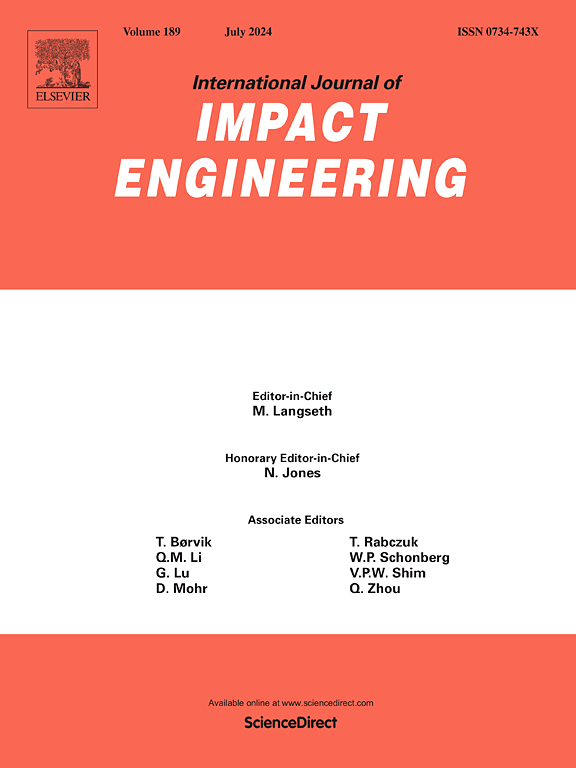Low-velocity penetration behavior of ice by steel projectile
IF 5.1
2区 工程技术
Q1 ENGINEERING, MECHANICAL
International Journal of Impact Engineering
Pub Date : 2024-11-09
DOI:10.1016/j.ijimpeng.2024.105163
引用次数: 0
Abstract
In this study, the penetration of a steel projectile into a semi-infinite ice target is investigated through experiment and numerical simulation. Five tests with initial impact velocity varying from 42.5 to 110 m/s are conducted. The penetrating behavior of the projectile and the dynamic response of the ice target are captured by a high-speed camera. The experimental results show that the impact velocity has great impact on the dynamic behavior and failure mode of the ice target. Under a low-speed impact, the ice target forms a crater at the impact surface. However, a penetration tunnel is formed under a high-speed impact. The crater diameter and penetration depth increase almost linearly with increasing the impact velocity. Furthermore, the numerical simulation for the tests is carried out using the continuum discontinuum element method (CDEM). The simulated penetration depth history of the projectile and the failure characteristics of the ice target agree with the experimental results, validating the numerical simulation model. It indicates that the ice crater angle keeps almost the same during a penetration. In addition, the maximum deceleration of the projectile and the maximum von Mises stress of the ice elements increase with increasing the impact velocity. These results provide the failure behavior and numerical simulation method for ice penetration, improving the understanding of dynamic fracturing mechanism of ice in engineering applications.
钢制弹丸对冰的低速穿透行为
本研究通过实验和数值模拟研究了钢制弹丸穿透半无限冰靶的情况。共进行了五次试验,冲击初速度从 42.5 米/秒到 110 米/秒不等。高速摄像机捕捉了弹丸的穿透行为和冰靶的动态响应。实验结果表明,冲击速度对冰靶的动态行为和破坏模式有很大影响。在低速撞击下,冰靶在撞击表面形成一个凹坑。然而,在高速冲击下会形成一个穿透隧道。随着撞击速度的增加,凹坑直径和穿透深度几乎呈线性增加。此外,试验的数值模拟是采用连续非连续单元法(CDEM)进行的。模拟的弹丸穿透深度历史和冰靶的破坏特征与实验结果一致,验证了数值模拟模型。结果表明,在穿透过程中,冰坑角度几乎保持不变。此外,弹丸的最大减速度和冰元件的最大 von Mises 应力随着撞击速度的增加而增大。这些结果提供了冰穿透的破坏行为和数值模拟方法,提高了工程应用中对冰的动态断裂机理的认识。
本文章由计算机程序翻译,如有差异,请以英文原文为准。
求助全文
约1分钟内获得全文
求助全文
来源期刊

International Journal of Impact Engineering
工程技术-工程:机械
CiteScore
8.70
自引率
13.70%
发文量
241
审稿时长
52 days
期刊介绍:
The International Journal of Impact Engineering, established in 1983 publishes original research findings related to the response of structures, components and materials subjected to impact, blast and high-rate loading. Areas relevant to the journal encompass the following general topics and those associated with them:
-Behaviour and failure of structures and materials under impact and blast loading
-Systems for protection and absorption of impact and blast loading
-Terminal ballistics
-Dynamic behaviour and failure of materials including plasticity and fracture
-Stress waves
-Structural crashworthiness
-High-rate mechanical and forming processes
-Impact, blast and high-rate loading/measurement techniques and their applications
 求助内容:
求助内容: 应助结果提醒方式:
应助结果提醒方式:


